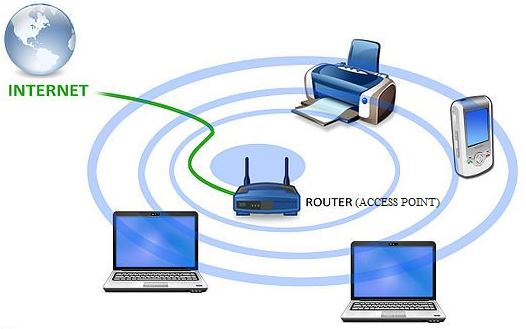Wi-Fi is the wireless networking technology that connects the device with the Internet. Rather than using wires it uses radio waves to transmit information. Wi-Fi stands for Wireless Fidelity.
When an antenna receives this radio wave, an electromagnetic field is created which can travel through space. It is based on IEEE 802.11 family of standards. Commonly they are employed in LAN systems for interconnecting of devices to access internet. Today almost all smart and computing devices operate on Wi-Fi. It has become the backbone of all current products and technologies.
IoT or Internet of Things is the interconnected network of computing devices that can transfer data over the network. IoT have diverse connectivity requirements ranging from power consumption requirements, data throughput rate, range, device cost etc. and the choice of Wi-Fi for connecting IoT devices have become an obvious choice.
Working of Wi-Fi
It is the Wi-Fi technology that keeps streaming audio and video from the Internet to your smartphones or tablets seamlessly. Let us see how Wi-Fi does this.
Any device equipped with a Wi-Fi adapter or a Wi-Fi card can receive radio waves transmitted from the Access Point (AP) such as an antenna or a router. A Wi -Fi Card can be installed on the mini PCI slot of your laptop or in the Airport slot of your Mac. This Wi- Fi card can connect to the broadcasting antenna or a router to receive the data from the internet.

Wi-Fi Hotspots
We might all be very familiar on Wi-Fi Hotspots but now let us see how does it work. A hotspot can be created by installing an Access Point in an area where Internet is readily available. We might frequently find Wi-Fi hotspots at public spaces like airports, railway stations, cinema theatres etc. It can give a coverage range of around 300 feet. Any device having Wi-Fi adapter can connect to this hotspot if they are within the required range of coverage. IEEE 802.11b is the most prominent standard for hotspots.
Wi-Fi and IoT
IoT has a very vast list of requirement specifications to address different scenarios of connecting the network such as geographic location, cost of devices, network range, bandwidth etc. Wi-Fi can give an optimal solution to all these requirements and can also combine with some other specialised protocols or technologies to serve the need.
Many IoT applications like Vehicle-to-Vehicle communication and Wi- Fi enabled security cameras can tap the bandwidth requirement of the Wi-Fi. The release and use of 5G combined with cloud can prioritise the capabilities of IoT to provide low latency data transfer and ultra-reliable low latency communications in IoT. It can uniquely give broadband and narrowband solutions for various IoT applications.
IoT devices use Wi-Fi to link them together as well as link them to Access Points that in turn can connect them to the web and cloud-based intelligence. The application should support cloud service support so that cloud-based application can be developed for the use of IoT.
Security and Installation of Wi-Fi Routers in IoT
Today most wireless routers come with a unique Service Set Identifier (SSID) and a pass phrase to login the router, so that once the router is on, it comes in the secure mode. Over the past decade most consumer electronics or computer systems which need to be connected to the Wi-Fi were equipped with a standard size keyboard or display but in the Internet of Things “things” can be really small to have a separate keyboard or display of considerable size. In such a case the routers can be configured by any other smart device which can connect it to the network of IoT.
Drawbacks of Wi-Fi in IoT
Wi-Fi can be an obvious choice of IoT connectivity because of its ease of installation and bandwidth, however it cannot be always an optimal choice. IoT devices are power hungry. Wi-Fi has limitations in both range and power efficiency. The IEEE have addressed all these limitations by publishing IEEE 802.11ah (Wi-Fi HaLow) and IEEE 802.11ax (HEW). Wi-Fi vendors continue to provide a more improved and efficient solution to IoT requirement like Zigbee and Bluetooth are now built-in the box.
Author
Anupama kumari
M.Tech (VLSI Design and Embedded system)
BS Abdur Rahman University
